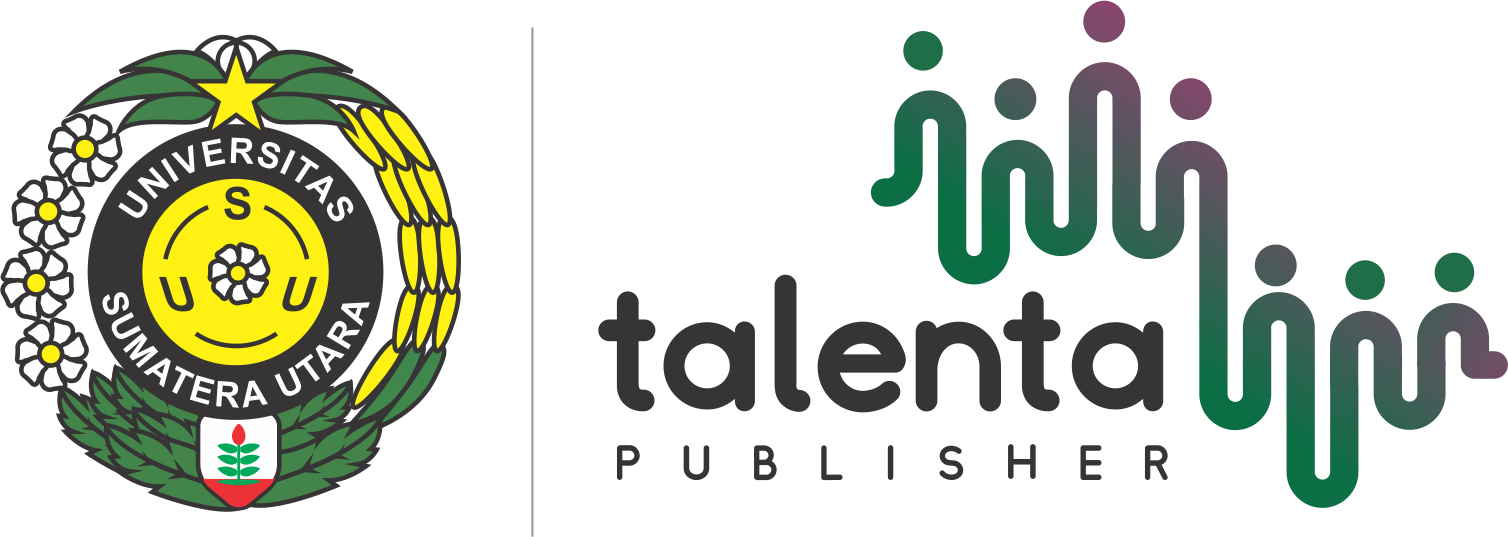Profitability and resource-use efficiency of tomato production in Lalitpur District, Nepal
DOI:
https://doi.org/10.32734/injar.v8i3.18264Keywords:
efficiency, profitability, regression, tomato productionAbstract
Tomato (Solanum lycopersicum L.) is one of the most commercially important and widely cultivated vegetable crops in the mid-hills of Nepal. Protected cultivation methods like polyhouses and rain shelters offer promising opportunities for improving yield and income, particularly during the off-season. However, limited empirical evidence exists on the economic viability and resource use efficiency of such practices at the local level. The study was conducted in the Lalitpur area to evaluate the profitability and resource use efficiency of tomato production. Primary data were gathered from 68 tomato producers using a pre-tested semi-structured questionnaire. The benefit-cost ratio was 1.15, indicating that tomato cultivation in the study area is profitable, with farmers earning an additional 15 paisa for every rupee invested. The analysis revealed that plant protection, fixed cost, and micro-nutrient had a positive and significant effect on gross returns from tomato cultivation, while other expenses (machinery operation, maintenance & irrigation) had a negative and significant effect. The return to scale was 1.23, indicating increasing returns to scale. Additionally, resources such as seed, plant protection, and micro-nutrients were found to be underutilized, while fertilizers, labor, fixed variables, and other inputs such as irrigation and machinery costs were overutilized. Therefore, improving profitability in tomato cultivation can be achieved by reducing expenditure on overutilized resources and increasing investment in underutilized resources. The findings have important implications for farmers, extension workers, policymakers, and future researchers.
Downloads
References
[1] C. Gebhardt, “The historical role of species from the Solanaceae plant family in genetic research,” Theoretical and Applied Genetics, vol. 129, no. 12, pp. 2281-2294, 2016, doi: 10.1007/s00122-016-2804-1.
[2] S. Knapp and I. E. Peralta, “The tomato (Solanum lycopersicum L., Solanaceae) and its botanical relatives,” in Solanaceae, Springer, pp. 7-21, 2016, doi: 10.1007/978-3-662-53389-5_2.
[3] Rashmi and Agnivesh, “A review on enhancing health-promoting effect of tomato,” Asian Journal of Research in Business Economics and Management, vol. 11, no. 11, pp. 47-53, 2021, doi: 10.5958/2249-7307.2021.00062.1.
[4] M. Subedi et al., “Production economics and resource use efficiency of tomato under open field condition in Kapilvastu, Nepal,” Journal of Agriculture and Natural Resources, vol. 3, no. 1, pp. 282-289, 2020, doi: 10.3126/janr.v3i1.27181.
[5] M. Y. Ali et al., “Nutritional composition and bioactive compounds in tomatoes and their impact on human health and disease: A review,” Foods, vol. 10, no. 1, p. 45, 2020, doi: 10.3390/foods10010045.
[6] S. Ouattara and M. Konate, “The tomato: A nutritious and profitable vegetable to promote in Burkina Faso,” Alexandria Science Exchange Journal, vol. 45, no. 1, pp. 11-20, 2024, doi: 10.21608/asejaiqjsae.2024.332758.
[7] S. Vats et al., “Unexplored nutritive potential of tomato to combat global malnutrition,” Critical Reviews in Food Science and Nutrition, vol. 62, no. 4, pp. 1003-1034, 2022, doi: 10.1080/10408398.2020.1832954.
[8] A. Kafle, “Introduction of vegetable sector and protected cultivation in Nepal and farm activities of vegetable crops development centre, Khumaltar, Lalitpur, Nepal,” RG, 2019, doi: 10.13140/RG.2.2.19251.48169.
[9] MoALD, “Statistical information on Nepalese agriculture 2021/22,” Kathmandu, Nepal: Planning & Development Cooperation Coordination Division, 2022. [Online]. Available: https://moald.gov.np/wp-content/uploads/2023/08/Statistical-Information-on-Nepalese-Agriculture-2078-79-2021-22.pdf.
[10] M. R. Haque, J. Ray, and M. A. Mannan, “Present scenario and problem confrontation of tomato (Solanum lycopersicum L.) growers in Khulna district,” South Asian Journal of Agriculture, pp. 51-55, 2019, doi: 10.3329/saja.v7i1-2.56754.
[11] P. B. Tanzubil and C. Boatbil, “Constraints to profitable dry season tomato and pepper production in the Kasena-Nankana and Talensi districts of the upper east region of Ghana with emphasis on pests and diseases,” Direct Research Journal of Agriculture and Food Science, vol. 2, no. 6, pp. 60-65, 2014.
[12] B. Chaulagai and B. Koirala, “Review on major constraints during off-seasonal tomato production in Nepal (Lycopersicon esculentum),” International Journal of Horticulture and Food Science, vol. 3, no. 2, pp. 57-61, 2021, doi: 10.33545/26631067.2021.v3.i2a.103.
[13] B. Pooja, V. Abdul Hakkim, and others, "Comparative evaluation of naturally ventilated polyhouse and rainshelter on the performance of tomato," Ph.D. thesis, Dept. Soil and Water Conservation Eng., 2017. [Online]. Available: http://14.139.181.140:8080//jspui/handle/123456789/380.
[14] P. Kumar, R. S. Chauhan, and R. K. Grover, “Economics analysis of tomato cultivation under poly house and open field conditions in Haryana, India,” Journal of Applied and Natural Science, vol. 8, no. 2, pp. 846-848, 2016, doi: 10.31018/jans.v8i2.883.
[15] Q. Ali, M. Ashfaq, and M. T. I. Khan, “An economic analysis of off-season tomato production in Punjab,” The Journal of Animal and Plant Sciences, vol. 27, no. 1, 2017.
[16] R. Singh, J. Kumar, and R. S. Jeewesh Kumar, “Off-season performance of tomato hybrids cultivation under natural ventilated polyhouse conditions in northern plains of India,” International Journal of Agricultural Science and Research, vol. 7, no. 4, pp. 635-640, 2017, doi: 10.24247/ijasraug201782.
[17] T. Pan et al., “Interaction of supplementary light and CO2 enrichment improves growth, photosynthesis, yield, and quality of tomato in autumn through spring greenhouse production,” HortScience, vol. 54, no. 2, pp. 246-252, 2019, doi: 10.21273/HORTSCI13709-18.
[18] H. Krishna et al., “Navigating challenges and prospects in off-season vegetable production,” Vegetable Science, vol. 51, Special Issue, pp. 97-105, 2024, doi: 10.61180/vegsci.2024.v51.spl.09.
[19] U. S. Nayak, S. R. Das, and G. Shial, “Perception and adoption level of improved off-season tomato cultivation practice among farm women of Odisha,” International Journal of Bio-Resource and Stress Management, vol. 11, no. 3, pp. 297-303, 2020, doi: 10.23910/1.2020.2111a.
[20] M. Job, “Study on changes in microclimatic parameters under poly-house with different color plastic mulching during tomato cultivation,” Journal of Pharmacognosy and Phytochemistry, vol. 7, no. 1, pp. 689-694, 2018.
[21] T. Yamane, Statistics: An Introductory Analysis, 2nd ed. New York: Harper & Row, 1967.
[22] M. Sharma, S. C. Dhakal, R. K. Adhikari, and U. Tiwari, “Profitability, productivity and resource use efficiency of banana production in Hetauda-Dumkibas road corridor, Nepal,” Cogent Food & Agriculture, vol. 7, no. 1, 2021, doi: 10.1080/23311932.2021.1917134.
[23] G. Pandey et al., “An analysis of vegetables and fruits production scenario in Nepal,” Asian Research Journal of Agriculture, vol. 6, no. 3, pp. 1-10, 2017, doi: 10.9734/ARJA/2017/36442.
[24] B. Kunwar and B. Maharjan, “Economic analysis of off-season tomato production under poly-house in Okhldhunga, Nepal,” Journal of Agriculture and Environment, vol. 20, pp. 67-77, 2019.
[25] A. Kumar, A. K. Rohila, and V. K. Pal, “Profitability and resource use efficiency in vegetable cultivation in Haryana: Application of Cobb-Douglas production model,” The Indian Journal of Agricultural Sciences, vol. 88, no. 7, pp. 1137-1141, 2018, doi: 10.56093/ijas.v88i7.81601.
[26] Mandla and M. K. Vaidya, “Production function analysis for vegetable cultivation in Kullu valley of Himachal Pradesh: Application of Cobb-Douglas production model,” Journal of Horticultural Sciences, vol. 18, no. 1, pp. 223-227, 2023, doi: 10.24154/jhs.v18i1.2168.
Downloads
Published
How to Cite
Issue
Section
License
Copyright (c) 2025 Indonesian Journal of Agricultural Research

This work is licensed under a Creative Commons Attribution-NonCommercial-ShareAlike 4.0 International License.



















